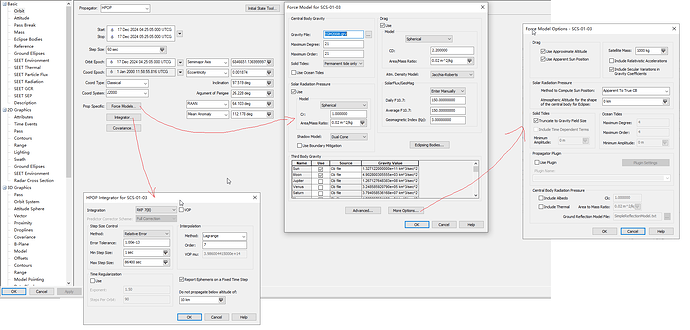hello everyone!
I am using orekit to calculate satellite ephemeris data. Without using the force models, the calculation results are basically consistent with STK. However, after adding the force models, the calculation results become increasingly different over time. How can I set these parameters in orekit?
Here is a screenshot of the parameters in STK:
Here is my code:
final double MASS = 1000;
final double CR = 1;
final double AREA_MASS_RATIO = 0.02;
final double AREA = MASS*AREA_MASS_RATIO;
final double DRAG_CD = 2.2;
final Orbit initialOrbit = new KeplerianOrbit(a, e, getIR(), getArgumentOfPerigeeR(), getRannR(), getMeanAnomalyR(), PositionAngleType.MEAN, frame, toAbsoluteDate(), Constants.WGS84_EARTH_MU);;
final AbstractIntegrator integrator = new DormandPrince853Integrator(1,86400, 1e-13, 1e-13);
final NumericalPropagator propagator = new NumericalPropagator(integrator);
// Moon
propagator.addForceModel(new ThirdBodyAttraction(CelestialBodyFactory.getMoon()));
// Sun
propagator.addForceModel(new ThirdBodyAttraction(CelestialBodyFactory.getSun()));
// gravity
var gravityField = GravityFieldFactory.getNormalizedProvider(21, 21);
HolmesFeatherstoneAttractionModel egm2008Model = new HolmesFeatherstoneAttractionModel(OrekitUtil.ITRF, gravityField);
propagator.addForceModel(egm2008Model);
// SolidTide
SolidTides solidTides = new SolidTides(OrekitUtil.ITRF, gravityField.getAe(), gravityField.getMu(), gravityField.getTideSystem(),false,
SolidTides.DEFAULT_STEP, SolidTides.DEFAULT_POINTS, IERSConventions.IERS_2010, TimeScalesFactory.getUT1(IERSConventions.IERS_2010, true), OrekitUtil.SUN, OrekitUtil.MOON);
propagator.addForceModel(solidTides);
// SolarRadiationPressure
SolarRadiationPressure forceModel =
new SolarRadiationPressure(OrekitUtil.SUN,OrekitUtil.EARTH,
new IsotropicRadiationSingleCoefficient(AREA, CR));
propagator.addForceModel(forceModel);
//Add air damping model, there is no default Jacchia Roberts model for STK here, so use Harris Priest model instead
// Atmosphere atm = new NRLMSISE00(new InputParams(), OrekitUtil.SUN, OrekitUtil.EARTH); //The difference between the NRLMSISE00 model results and STK is greater
Atmosphere atm = new HarrisPriester(OrekitUtil.SUN, OrekitUtil.EARTH);
var dragForce = new DragForce(atm, new IsotropicDrag(AREA, DRAG_CD));
propagator.addForceModel(dragForce);
final SpacecraftState initialState = new SpacecraftState(initialOrbit, MASS);
propagator.setInitialState(initialState);
final EphemerisGenerator generator = propagator.getEphemerisGenerator();
propagator.propagate(OrekitUtil.toAbsoluteDate(endTime));
final BoundedPropagator ephemeris = generator.getGeneratedEphemeris();
while (startTime.isBefore(endTime) || startTime.equals(endTime)){
SpacecraftState intermediateState = ephemeris.propagate(startTime);
GeodeticPoint geo = OrekitUtil.EARTH.transform(intermediateState.getPVCoordinates().getPosition(), intermediateState.getFrame(), intermediateState.getDate());
System.out.println(geo);
startTime = startTime.shiftBy(step);
}
